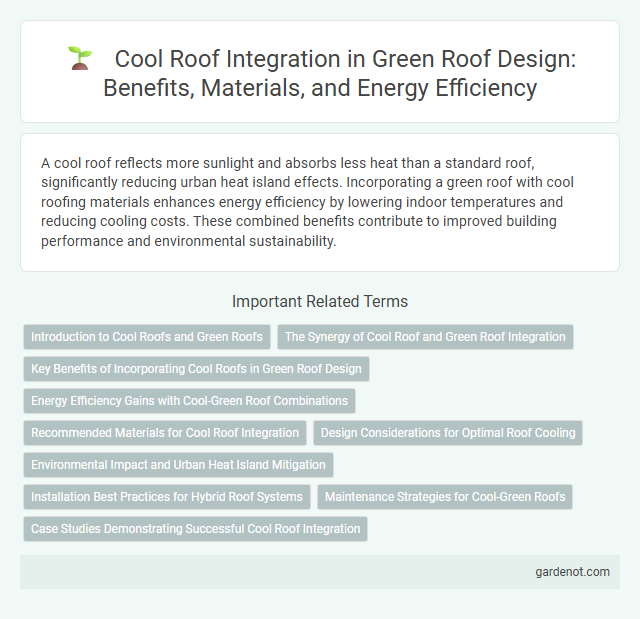A cool roof reflects more sunlight and absorbs less heat than a standard roof, significantly reducing urban heat island effects. Incorporating a green roof with cool roofing materials enhances energy efficiency by lowering indoor temperatures and reducing cooling costs. These combined benefits contribute to improved building performance and environmental sustainability.
Introduction to Cool Roofs and Green Roofs
Cool roofs and green roofs are innovative roofing solutions designed to reduce urban heat and improve energy efficiency. Cool roofs use reflective materials to bounce sunlight and absorb less heat, lowering building temperatures and energy costs. Green roofs incorporate vegetation layers that provide natural insulation, enhance air quality, and manage stormwater runoff effectively.
The Synergy of Cool Roof and Green Roof Integration
Combining cool roofs and green roofs enhances urban heat island mitigation by reflecting solar radiation and providing natural insulation through vegetation. This integration improves energy efficiency in buildings by reducing cooling loads and managing stormwater more effectively than either system alone. Studies show that dual roofing systems can lower rooftop temperatures by up to 30%, increasing roof lifespan and contributing to sustainable urban development.
Key Benefits of Incorporating Cool Roofs in Green Roof Design
Incorporating cool roofs in green roof design significantly reduces urban heat island effects by reflecting solar radiation and lowering rooftop temperatures. This integration enhances energy efficiency, leading to decreased cooling costs and extended lifespan of roofing materials. Furthermore, combining cool roofs with vegetation improves stormwater management and air quality, creating a sustainable and resilient building envelope.
Energy Efficiency Gains with Cool-Green Roof Combinations
Cool-green roof combinations enhance energy efficiency by integrating reflective cool roof materials with vegetative layers, significantly reducing heat absorption and improving insulation. Studies show these hybrid systems can lower building cooling loads by up to 30%, resulting in substantial energy savings and reduced urban heat island effects. The synergy between the reflective surface and plant transpiration optimizes temperature regulation, making cool-green roofs a superior sustainable roofing solution.
Recommended Materials for Cool Roof Integration
Recommended materials for cool roof integration include highly reflective coatings such as acrylic, silicone, and elastomeric paints designed to reflect solar radiation and reduce heat absorption. Incorporating white or light-colored roofing membranes made from materials like TPO (thermoplastic olefin) and PVC (polyvinyl chloride) enhances thermal performance by maximizing solar reflectance and minimizing thermal emittance. These materials improve energy efficiency and complement green roof systems by reducing urban heat island effects and lowering building cooling loads.
Design Considerations for Optimal Roof Cooling
Cool roof design considerations prioritize high solar reflectance and thermal emittance materials to reduce heat absorption and enhance roof cooling efficiency. Incorporating light-colored or reflective roof membranes, along with appropriate insulation and ventilation strategies, optimizes the energy dissipation process and minimizes urban heat island effects. Strategic integration of vegetation in green roofs can complement cool roof properties by providing additional shading and evapotranspiration cooling benefits.
Environmental Impact and Urban Heat Island Mitigation
Cool roofs significantly reduce urban heat island effects by reflecting more sunlight and absorbing less heat compared to traditional roofs. Their high solar reflectance lowers surface temperatures, decreasing energy consumption for cooling and reducing greenhouse gas emissions. By mitigating heat buildup, cool roofs improve outdoor air quality and promote urban environmental sustainability.
Installation Best Practices for Hybrid Roof Systems
Proper installation of hybrid green and cool roof systems involves selecting compatible materials to maximize thermal regulation and energy efficiency. Integrating a reflective cool roof membrane beneath the vegetative layers reduces heat absorption, while ensuring adequate waterproofing and root barriers prevents structural damage. Regular inspection and maintenance are critical to sustain optimal performance and extend the lifespan of hybrid roof installations.
Maintenance Strategies for Cool-Green Roofs
Maintenance strategies for cool-green roofs involve regular inspection and cleaning to remove debris and prevent algae or moss growth, which can reduce reflective properties. Ensuring proper irrigation and plant care supports the vegetation's health, enhancing cooling performance and stormwater retention. Using non-toxic, eco-friendly cleaning agents preserves both the roof's reflective surfaces and the green roof's ecosystem.
Case Studies Demonstrating Successful Cool Roof Integration
Case studies from cities like New York and Los Angeles highlight the successful integration of cool roofs, showing significant reductions in urban heat island effects and energy consumption in commercial buildings. Research conducted by the Lawrence Berkeley National Laboratory reveals that cool roofs lower rooftop temperatures by up to 30degF, contributing to energy savings of 15-20% on air conditioning costs. These documented outcomes underscore cool roofs as effective components in sustainable urban planning and climate adaptation strategies.
Cool roof Infographic

 gardenot.com
gardenot.com